TwiKnight
by Jens Bęk Nielsen
Opening
While reading about chess variants, a new one with a simple rule suddenly occured to me: once in a game you may make a doublemove with a knight (f.ex. Ne5xf7xh6+).
Perhaps inspired by bouncy chess where similar moves may occur at the border. The knight may move twice; hence the name twiknight.

This diagram makes some details about the rule clear.
A) It is allowed to be in check after the first part of the doublemove. Although Nf4 is pinned, it is allowed to play Nh3xf2 with the doublemove. B) The twiknight must use a distinct square in the middle of it's doublemove. If Ne5 captures Rh8 with a doublemove, it must capture the pawn at g6. If the pawn at g6 were a white pawn, the rook could not be captured at all (just like backgammon: if you move twice with a checker it must pass an unblocked "square").
Out of book
I started to play some games with Torben Osted, but the game didn't work yet. We feared that the doublemove was more worth than a piece, and it was confirmed by two games. Torben Osted was white and can force to give a piece for the doublemove.
Game 1.
1.Nc3
with the threat Nb5#. Ne4 is not mate - it is covered by Ng8
1. ...,Nc6
2.Nb5+,Nd4xb5
3.c4,Nd4
4.e3,Ne6
5.d4,d5
6.Nf3, Resign
threats 7.Ne5 catching Qd8 1-0
Early to resign, but 6. ...,c6 7.Ne5,Qc7 (only square) 8.exd5 is hopeless, as 8. ...,cxd5 9.Bb5+ wins the Queen.
Also hopeless is 6. ...,f6 7.cxd5,Qxd5 8.Bc4!
8. ...,Qh5 9.g4!
8. ...,Qa5+ 9.Nd2! (threats on a5 & e4) 9. ...,Qf5 10.f3
8. ...,Qd8 9.Nd2!,f5 10.Nf3
Game 2.
1.Nc3,c6
better, but after
2.Ne4+,Nf6xe4
3.d3,Nf6
white won in 25 moves.
I thought of limiting the power of the twiknights by prohibit the knights to move the first two moves. This should give the players time to make moves to defend against the twiknights.
Early midgame
Peter Wood got me in contact with Ian G. Richardson, and Ian came independently up with my rule: The knights must not move until move 3. But Ian came up with another interesting rule, that speeds the game up: Even though you have used your doublemove, your knights always attack the enemy king with a doublemove.
This rule has turned out to be so essential, that you can consider to drop the doublemove, but this has yet to be tried.
Ian had made some studies with these rules, and I also made some before we started playing games.
Jens Bęk Nielsen.

Mate in 2 moves.
Jens Bęk Nielsen.
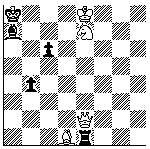
Mate in 3 moves.
Ian G. Richardson.
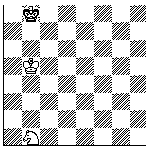
Mate in 4 moves.
Solutions:
Mate in 2 moves: 1.Rd4!, Kxd4 2.Ng6-f4#. On other black moves white mates by Nf7-d6.
This position demonstrates the power of the twiknight.
Mate in 3 moves: 1.Ba4,Rxe2 2.Bxc6+,Kb8 (Ne7 does not cover b8 when a white piece is on c6) 3.Be4#. A new way of giving check by opening a rute by moving another piece.
1. ...,Kb7 2.Bxc6+,Kb6 3.Qb5#.
1. ...,Bc5 2.Qa6+,Ba7 2.Qxa7#.
Mate in 4 moves: 1.Nc3-d5!,Kb7! 3.Kc5,Kb8/a7 2.Kc6,Ka7/b8 4.Nc7/b6#.
1. ...,Ka7 2.Kc6,Kb8 3.Nb6# 1.Kc6? looks good, but doesn't work.
Late midgame
Game 1; black=Ian G. Richardson:
1.c4,c6
2.c5,e6??
black had only eyes for Nc3-b5+, but white made c4 available again with his second move:
3.Na3-c4+,resigns.
If 3. ...,Ke7 4.Nd6#.
Game 2; white=Ian G. Richardson:
1.e3,d5
2.d4,Bg4
3.f3
I thought of 3. ...,Nf6 4.fxg4,Ne4 and whites queen is trapped, but
A: 5.Nh3 with the threats 6.Nf4-h5# and 6.Nf2xe4 and white has a bishop for the doublemove (enough!?)
B: 5.Na3!?,c6 (5.-,Nc3xd1?? 6.Nb5+,Kd7 7.Nf3#) 6.Nh3!,g6 7.Nf4,Qd7 8.Nxg6xh8 - but even with 9.any,Nc3xd1 10.Kxd1 has white too much for the queen: a twiknight, a bishop, the pair of bishops and two twiknights with a doublemove against a single twiknight.
3. ...,Bh5
4.Nc3,c6
5.Nh3,e5!?
At this point I won the first game and was ready to risc something to get an amusing game.
6.dxe5,Nd7!
This saves the doublemove as a threat for later use. After 6. ...,Nd7xe5+ 7.Ke2,Nh6 8.e4 I could not find anything.
White can now - after 6.-,Nd7! - try to cover e5:
7.Ng5?,Qxg5! 8.Ne4xg5,Nxe5+ 9.Ke2,Nxf3xg5+ with a pawn and two twiknights against one.
7.Qd4,Nh6 (threats Nf5xd4+. Unclear is 7.-,Bc5!? 8.Na4xc5...) 8.Qf4?,Nxe5+ 9.Qxe5+,Ng4xe5+
7.Nf4(Nf2),Nc5+ (8.Ke2,Nh6-f5#) 8.Na4xc5,Bxc5 9.Nxh5+,Nf6xh5 with a twiknight against a bishop.
7.Bd3,Nxe5+
If now 8.Ke2,Nxf3-g1+ 9.Ke1,Bxd1 10.Rxg1 and white has only a knight and the doublemove for the queen.
8.Kf1
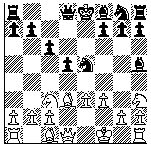
If now 8. ...,Qh4? (with the threat 9. ...,Bxf3 10.Ng5xf3,Qf2#) 9.Nf4!,Bxf3? and white simply plays 10.Nxd5-c7+,Kd7 11.Bf5# instead of 10.gxf3,Qf2+! 11.Nh3xf2,Nf6-h5#.
But black can reverse his moves:
8. ...,Bxf3!?
9.gxf3,Qh4
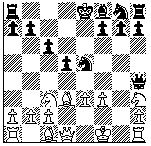
10.Kg2?,Qxh3+!
11.Kxh3,Nf6-h5#
10.Ne2!?,Nxf3+ (11.Ng5xf3?,Nf6-g4+ 12.Kg1,Qf2#) 11.Nd4xf3,Nf6-g4+ 12.Kg1,Qxh3 - is black better?
Best was 10.Nxd5-c7+,Kd7 11.Nxa8+,Ke7 12.Nc7+ with perpetual check. Notice 12.Nf4+?,Qxf4! 13.exf4,Nf6-h5#.
I had hoped for the interesting 10.Nf4?!,Qxf4!? 11.Ne2xf4,g5 (the knight cannot move because it must cover Nf6-h5#) 12.h4,gxf4 12.h5,fxe3 (13.Bxe3? Ng4xe3+)
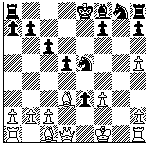
(analyse)
Black has surprisingly enough for the queen... (If white had played 11.Nxd5xf4 black would now have 12.-,Nf6-d5#.)
Game 3; black=Ian G. Richardson:
1.c4,e5
2.g4,Bc5
3.Bg2?

my idea in this game was to get control of e4. A knight there would check black. I thought of 3.g5 and if black later played Ng8-e7 - it's only square - it didn't cover e4. But 3. ...,f5 was a good move for black after 3.g5.
I was not afraid of 3. ...,Bxf2+ and 4. ...,Qh4+ because of the answer 5.Nf3xh4.
3. ...,Bxf2+!
4.Kxf2
Has black really missed that 4.-,Qh4+ can be answered by the doublemove Nf3xh4?
4. ...,Qh4+!!
No! This is a brilliant combination with a bishopsacrifice followed by a queensacrifice!
When I send my 10.-,Qxh3+! in the previous game, I received 4.-,Qh4+!! in this game. As Ian wrote to me it was amazing, that we both had eye for a queensacrifice followed by the powerfull attack of two twiknights, but had no eye for the opponents similar combination.
5.Nf3xh4,Nf6+
6.Kf3,Nc6-d4#
6.Kf1,Nxg4+
7.Kg1,Nc6-d4#
Endgame
These games has given an interesting observation. In normal chess we use these odd values for the pieces:
P=1, N=3, B=3, R=5, Q=9
But TwiKnight "repairs" this and gives these straight values:
P=1, B=3, R=5, N=7, Q=9
The above studies and games shows clearly, that this chess variant has a lot of active and interesting play - the twiknight influences the game all the way through.
It has a good speed, and in my point of view it has an advantage to progressive variants, where series of 6-7 moves or more are so hard to calculate that it is a little random who wins the game.
Endgames are also impossible in progressive variants, but should with a little practice be possible in twiknight.
So enjoy yourself with these...

Rules for TwiKnight:
1. The knights can make a doublemove.
1a. It is only allowed once in a game.
1b. It is allowed to be in check after the first part of the doublemove.
1c. The twiknight must use a distinct square in the middle of it's doublemove.
2. The knights must not move until move 3.
3. The knights always attack the enemy king with a doublemove.

From ETEROSCACCO Magazine n.67.
ETEROCHESS (Fabio Forzoni) page
 since 16 Mar. 1997; Last Updated: 8 Feb. 1998
since 16 Mar. 1997; Last Updated: 8 Feb. 1998
© Fabio Forzoni 1997










